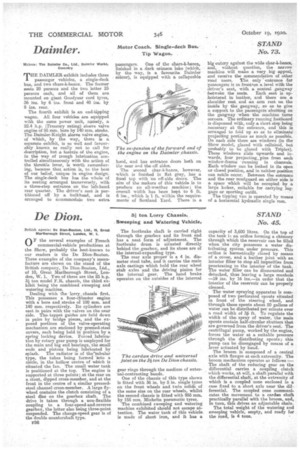Daimler.
Page 44

If you've noticed an error in this article please click here to report it so we can fix it.
Motor Coach. Single-deck Sus. Tip Wagon.
STAND No. 73.
Makers: The riainfier Co., Ltd., Daimler Works, Coventry.
rrHE DAIMLER exhibit includes three passenger vehicles, a single-deck bus, and two chars-à-bancs. The former seats 29 persons arid the two latter 25 persons each, and all ei them are mounted on giant Goodyear cord tyres, 36 Ms. by 6 ins. front and 40 ins. by 8 ins. rear.
The fourth exhibit is an end-tipping wagon. All flaw vehicles are equipped with the same power unit, namely, a 22.4 h.p. (Treasury rating) sleeve valve engine of 95 nine bore by 140 mm. stroke.. The Daimler-Knight sleeve valve engine, of which, by the way, there is a separate exhibit, is so well and favourably known as really net to call for description, but a featuee cif the engine, in the way of trough lubrication controlled simultaneously with the a,ctioe of the throttle lever, is worth remembering, because that action is, to the beet of our belief, unique in engine design. The single-deck bns has the whole of its seating arranged transversely, with a three-step entrance on the left-hand rear querter. The driver's seat is partitioned off by a bulkhead, and is arranged to accommodate two extra passengers. One of the chars-i-bancs, finished in a dark crimson lake (which, by the way, is a favourite Daimler colour), is equipped with a collapsable
hood, and has entrance doors both on the near and the off sides.
The second chereehancs, however, which is firsiehed in fiat gray, has a fixed top with no off-side doors. The aim of the makers of this vehicle is to produce an all-weather machine; the overall width has been kept to 6 ft. 6 ins., which is 1 ft. within, the requirements of Scotland Yard. There is a big outcry against, the wide char--banes, and, without question, the narrow machine will make -a very big appeal, and receive the oommendation of other road mete. The only 'entrance for passengers is m Irene= a level with the driver's seat, with a central gangway between the seats. Each seat is upholstered in leather, and there are a shoulder rest and an arm rest on the inside by the gangway, so as to give a support to the passengers 'abutting on the gangway when the machine turns corners. The ordinary running footboard is dispensed with, only a short step being necessary at the entrance, and this is arrasiged to fold up BO as to eliminate' projecteng portions as much as possible. On each side these are windows (in this Show model, glazed with celluloid, but probably to be glazed with Triplex). These windows slide upwards and inwards, four projectingepine from each window-frame • running in channels. Each window can 'be 17:eked in its open or closed position, .and neither.poeibion can rattle occur. Between the entrance and the rear Mudguard on either side is a apace which will he occupied by a large locker, suitable for carrying luggage or sporting outfit.
The tipping van is operated by means of a horizontal hydraulic single rem,












































































